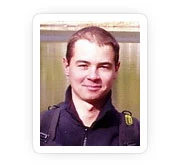Yoga Anatomy: Antagonist/Synergist Combinations In Yoga

In this post, we explore the relationship between the tensor fascia lata (TFL) and the gluteus maximus. In addition, I add a cue for engaging the adductor magnus as a synergist of the gluteus maximus. Knowledge of these relationships can be used to refine and stabilize postures with a lunge component, such as Warrior II.
The “Deltoid” of the Hip
You might think of the tensor fascia lata as akin to the anterior deltoid of the shoulder in that it flexes and internally rotates the joint. The gluteus maximus is similar to the posterior deltoid in that it extends and externally rotates the articulation. Both muscles can abduct the hip. They are thus antagonists for flexion/extension and rotation and synergists for abduction.

(The deltoid of the shoulder and the “deltoid” of the hip)
The gluteus medius and minimus lie between the tensor fascia lata and the gluteus maximus and are comparable to the central portion of the deltoid. They are abductors and, depending on the position of the hip joint, synergists of the tensor fascia lata or gluteus maximus. For example, if the hip is flexing and internally rotating, the gluteus medius and minimus synergize the tensor fascia lata for these actions. If the hip is extending and externally rotating, they synergize the gluteus maximus. For this reason, the combination of the tensor fascia lata and gluteals is sometimes referred to as the “deltoid” of the hip.
The front hip in Virabhadrasana II (Warrior II Pose) flexes, abducts, and externally rotates. This combination of movements is known as “circumduction” and it involves the contributions of several muscles. The tensor fascia lata and gluteals produce the abduction component. Depending on the position of the joint, each of these muscles has several possible actions, which can synergize or oppose one of the other muscle’s actions. Throughout the range of motion of the hip, the tensor fascia lata and gluteus maximus form an antagonist/synergist pair.
Here’s the Cue
In Warriors I and II, I bring the front knee in line with the hip and ankle and then gently press the sole of the foot into the mat. This activates the TFL and gluteus maximus, respectively (the quadriceps also engage). Press the back foot into the mat to stabilize it and then gently attempt to drag it away from the front foot. This acts to extend and abduct the hip and stabilize the pelvis. I balance these cues for the front and back legs and ease back on muscular force as I attain stillness in the pose. (see illustration below left)

Add the Adductor Magnus
As an additional refinement, I engage the adductor magnus by gently attempting to drag or “scrub” the back foot inward toward the midline (adducting it) (see illustration below right). Because the foot is constrained by the mat, the force of this action is transmitted to the origin of the muscle, as shown here. I have found that this cue works especially well in Warrior I for refining the position of the pelvis.

(Engaging the gluteus maximus and tensor fascia lata in Warrior II. )
The overall effect of these actions is to produce a series of forces that stabilize the asana from the foundation to the core. I get a feel for these cues first by using them in a shallower variation of the pose and build the muscular engagement gradually. This helps with stability and awareness.
(Engaging the back-leg adductor magnus in Warrior I.) (see illustration right)
Always, in your particular case, consult your health care provider before practicing yoga or any other exercise program. Always practice yoga under the direct supervision of a qualified instructor.
More on the tensor fascia lata (TFL) from Ray Long, MD –Yoga Anatomy: How to Engage Your Tensor Fascia Lata for a Stronger Parsvakonasana.
Study knee health with YogaUOnline and Doug Keller – Yoga for Healthy Knees: Keys to Retaining Lifelong Mobility.
Reprinted with permission from Daily Bandha.
Illustrations by the Daily Bandha.
 Author Ray Long MD, FRCSC is a board-certified orthopedic surgeon and the founder of Bandha Yoga. Ray graduated from The University of Michigan Medical School with post-graduate training at Cornell University, McGill University, The University of Montreal and Florida Orthopedic Institute. He has studied hatha yoga for over twenty years, training extensively with B.K.S. Iyengar and other leading yoga masters.
Author Ray Long MD, FRCSC is a board-certified orthopedic surgeon and the founder of Bandha Yoga. Ray graduated from The University of Michigan Medical School with post-graduate training at Cornell University, McGill University, The University of Montreal and Florida Orthopedic Institute. He has studied hatha yoga for over twenty years, training extensively with B.K.S. Iyengar and other leading yoga masters.
 3d Graphic Designer / Illustrator Chris Macivor has been involved in the field of digital content creation for well over ten years. He is a graduate of Etobicoke School of the Arts, Sheridan College and Seneca College. Chris considers himself to be equally artistic and technical in nature. As such his work has spanned many genres from film and television to video games and underwater imagery.
3d Graphic Designer / Illustrator Chris Macivor has been involved in the field of digital content creation for well over ten years. He is a graduate of Etobicoke School of the Arts, Sheridan College and Seneca College. Chris considers himself to be equally artistic and technical in nature. As such his work has spanned many genres from film and television to video games and underwater imagery.



